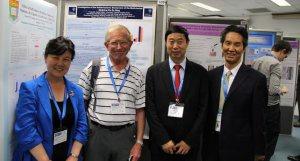阿奇霉素可减少支气管扩张症加重次数
1996年获批现已得到广泛应用的药物如今有了新用途,它可以明显减少疾病的加重次数,推迟非囊性纤维化支气管扩张症患者的首次加重时间,至少可以比上一年减少一次加重次数。
“使用阿奇霉素控制病情加重的支气管扩张症患者的大环内酯类药物治疗效果”(EMBRACE)试验由新西兰研究人员进行。结果发表在8月18日的《柳叶刀》杂志上。该期杂志为呼吸病学专刊,恰好在奥地利维也纳举办的欧洲呼吸学会年会之前发表。
非囊性纤维化支气管扩张症是一种使人极度虚弱的慢性疾病,导致肺功能进行性下降。患者出现呼吸道炎症,通常由嗜中性粒细胞入侵、长期细菌感染、复发性肺病加重及排痰性咳嗽等引起。
虽然这种疾病的流行情况尚不清楚,“但是,凭借现代诊断技术,人们对支气管扩张症的了解越来越多。1993年至2006年,美国的支气管扩张症相关住院人数每年增长2%-3%,同期年平均住院率为十万分之十六点五,”首席研究员、新西兰奥克兰市Middlemore医院呼吸病内科Conroy Wong博士说。
目前,针对这些患者的循证治疗方案不多。大环内脂类抗生素阿奇霉素既有抗炎性又有免疫调节功能。Dr. Wong告诉《医景医学新闻》,“大环内脂类抗生素对支气管扩张症的作用机制是多方面的……,本研究目的不是专门评价它的作用机制,但是,阿奇霉素看来很可能具有抗菌和抗炎这两种作用机制。本研究暗示,痰培养时细菌减少(抗菌效果),阿奇霉素组血液和痰中的中性白细胞计数下降。”
新西兰3家中心的一项随机双盲安慰剂对照试验对阿奇霉素是否可以减少疾病加重次数、改善肺功能进行了研究。参试者年龄≥18岁,参试前一年至少发生一次需要抗生素治疗的肺病加重,支气管扩张症由高分辨CT扫描确诊。2008年2月12日至2009年10月15日,研究人员共纳入患者141例,随后随机分配接受500mg阿奇霉素或安慰剂治疗,一周3次,共6个月。阿奇霉素组治疗期间加重次数明显少于安慰剂组(42 : 103)。
研究达到一项复合观察终点:6个月治疗期间,基于事件的加重率分别为:阿奇霉素治疗组71例,0.59%;安慰剂组70例,1.57%。此外,加重率相对减少62%(比率,0.38,95%置信区间[CI],0.26 - 0.54;P < .0001)。
6个月试验期间,阿奇霉素组患者几乎未有疾病发作,因此,研究人员将至少25%患者出现首次加重的时间确定为首次加重时间。该时间为,阿奇霉素组104天(95% CI,48 - 186),安慰剂组21天(95% CI,11 - 48)(危害比[HR],0.34;P < .0001)。12个月治疗和随访期首次加重中位时间,阿奇霉素组239天(95% CI,190 - 331),安慰剂组85天(95% CI,52 - 113)(HR,0.44;P < .0001)。
试验结束后,患者继续受益于治疗。Dr. Wong称,“本次研究结果显示,6个月阿奇霉素治疗减少加重次数,推迟首次加重时间,这些好处似乎可在治疗后持续6个月。”
研究未达到其他2个复合观察终点。阿奇霉素组支气管扩张前1秒钟用力呼气量与基线相同,安慰剂组下降0.04L(95% CI,0.03 - 0.12;P = .251)。两组圣??乔治呼吸问卷总分数接近,组间差异–3.25 (95% CI,–7.21 - 0.72;P = .108)。阿奇霉素组加重风险减半,分别有31%的阿奇霉素组患者和66%的安慰剂组患者报告,治疗期间至少出现一次加重。
研究人员得出结论,阿奇霉素是预防非囊性纤维化支气管扩张症患者疾病加重的新选项,不过,研究人员也建议临床医师“要谨慎选择接受阿奇霉素长期治疗的患者,因为越来越多的人担心会出现大环内脂类药物抗药性。”
在随刊评论中,英国伦敦皇家布朗普顿医院的Robert Wilson博士和Athol Wells博士指出,这次大型前瞻性研究,为“非囊性纤维化支气管扩张症便宜疗法的良好疗效提供了明确的证据。”他们还敦促注意增加大环内脂类药物的抗药性,建议进行更多研究,以确定阿奇霉素对哪些患者好处最大。“对疾病严重性的前瞻性评估和事先考虑纵向性疾病行为方式可以为未来研究确定干预受益最大的支气管扩张症患者提供最佳的机会,”
Dr.Wong指出,“随着对大环内脂类药物抗药性担心的增加,研究人员已经在关注大环内脂类的非抗菌功效。现在已经从阿奇霉素和红霉素中衍生出新的药剂,目前正处于早期研制阶段。这些药剂没有抗菌功效,因此,较少甚至没有抗药性风险,不过,似乎有抗炎和免疫调节功效。”
英文全文见下:
Azithromycin Lessens Bronchiectasis Exacerbations
August 22, 2012 — A new application of a drug that was approved in 1996 and has been widely used since significantly decreased the frequency of exacerbations and increased the time to first exacerbation in patients with noncystic fibrosis bronchiectasis and at least 1 exacerbation during the previous year.
The Effectiveness of Macrolides in Patients with Bronchiectasis Using Azithromycin to Control Exacerbations (EMBRACE) trial was conducted by a team of researchers from New Zealand. The results were published in the August 18 issue of the Lancet. The issue is devoted to respiratory medicine and was released just ahead of the European Respiratory Society Annual Congress being held in Vienna, Austria.
Noncystic fibrosis bronchiectasis is a highly debilitating chronic condition that results in a progressive decline in lung function. Patients experience inflammation of the airways caused by neutrophil invasion, chronic bacterial infection, recurrent pulmonary exacerbations, and a productive cough.
Although the prevalence of this condition is not known, “with modern diagnostic techniques, bronchiectasis is increasingly being recognized. In the United States, the number of bronchiectasis-associated admissions increased by 2% to 3% per year between 1993 and 2006, and the mean annual rate of admission in this period was 16.5 per 100,000 people,” according to lead investigator Conroy Wong, **hB, from the Department of Respiratory Medicine at Middlemore Hospital in Auckland, New Zealand.
Few evidence-based therapeutic options exist for these patients. Azithromycin, a macrolide antibiotic, has both antiinflammatory and immunomodulatory properties. As Dr. Wong explained to Medscape Medical News, “there are multiple potential mechanisms of action of the macrolide antibiotics in bronchiectasis… Our study was not designed to specifically evaluate the mechanism of action, but it seems likely that azithromycin acts by both antibiotic and antiinflammatory mechanisms. Our study hinted at a reduction in organisms cultured in sputum (antibiotic effect) and showed reduced blood and sputum neutrophil counts in the azithromycin group.”
Whether azithromycin can decrease the frequency of exacerbations and improve lung function was tested in a randomized, double-blind, placebo-controlled trial conducted at 3 New Zealand centers. Trial participants were 18 years or older and had to have had at least 1 pulmonary exacerbation requiring antibiotic treatment in the previous year plus bronchiectasis diagnosed by high-resolution computed tomography scan. The researchers enrolled 141 patients from February 12, 2008 to October 15, 2009, and subsequently randomized them to receive azithromycin 500 mg or placebo 3 times a week for 6 months.
The number of exacerbations during the treatment period was much lower in the azithromycin group than in the placebo group (42 vs 103)。
The study met one of the coprimary end points: the rate of event-based exacerbations during the 6-month treatment period was 0.59 per patient in the 71 patients who received azithromycin and 1.57 per patient in the 70 patients who received placebo. In addition, a 62% relative reduction in the rate of exacerbations was seen (rate ratio, 0.38; 95% confidence interval [CI], 0.26 to 0.54; P < .0001)。
Because few patients in the azithromycin group experienced an episode during the 6-month trial, researchers defined time to first exacerbation as the time until at least 25% of the patients had a first exacerbation. This time was 104 days (95% CI, 48 to 186) in the azithromycin group and 21 days (95% CI, 11 to 48) in the placebo group (hazard ratio [HR], 0.34; P < .0001)。 Over the 12-month treatment and follow-up period, median time to first exacerbation was 239 days (95% CI, 190 to 331) in the azithromycin group and 85 days (95% CI, 52 to 113) in the placebo group (HR, 0.44; P < .0001)。
Patients continued to benefit from the treatment after the trial ended. According to Dr. Wong, “our results show that azithromycin treatment for 6 months decreases the frequency of exacerbations and increases the time to first exacerbation. These benefits seem to persist for 6 months after the treatment is completed.”
The study did not meet the other 2 coprimary end points. Forced expiratory volume in 1 s before bronchodilation did not change from baseline in the azithromycin group; in the placebo group, it decreased by 0.04 L (95% CI, 0.03 to 0.12; P = .251)。 The total score on the St. George's Respiratory Questionnaire was similar in the azithromycin and placebo groups; the difference between the groups was –3.25 (95% CI, –7.21 to 0.72; P = .108)。
The risk for an exacerbation was halved with azithromycin; 31% of the azithromycin group and 66% of the placebo group reported at least 1 exacerbation during the treatment period.
The researchers conclude that azithromycin is a new option for the prevention of exacerbations in patients with noncystic fibrosis bronchiectasis, but recommend that clinicians take “a careful approach to the selection of patients for long-term azithromycin treatment because of increasing concerns about macrolide resistance.”
In an accompanying comment, Robert Wilson, MD, and Athol Wells, MD, both from the Royal Brompton Hospital in London, United Kingdom, explain that this study provides “clear evidence for a beneficial effect of an inexpensive treatment for noncystic fibrosis bronchiectasis in a large prospective study.” They too urge caution in light of increasing macrolide resistance, and suggest additional study to determine which patients could benefit most from azithromycin. “The prospective assessment of disease severity and thea prioriconsideration of patterns of longitudinal disease behavior could provide the best chance in future studies to identify patients with bronchiectasis with the most to gain from an intervention.”
Dr. Wong noted that “with increasing concerns about macrolide resistance, researchers have been focusing on the nonantibiotic effects of macrolides. There are new agents derived from azithromycin and erythromycin that are in early-phase development. These agents do not have antibiotic effects, therefore less or no risk of resistance, but appear to have the antiinflammatory and immunomodulatory effects.”
本站所注明来源为"爱爱医"的文章,版权归作者与本站共同所有,非经授权不得转载。
本站所有转载文章系出于传递更多信息之目的,且明确注明来源和作者,不希望被转载的媒体或个人可与我们
联系zlzs@120.net,我们将立即进行删除处理
热点图文
-
牛津大学:心速宁胶囊作用机制研究成果发表
2015年5月19日,由澳大利亚药理学会和英国药理学会主办的澳-英联合药理...[详细]
-
GM制药Epidiolex获FDA孤儿药资格
2月28日,GW制药宣布美国FDA授予该公司用于治疗儿童Lennox-Ga...[详细]


